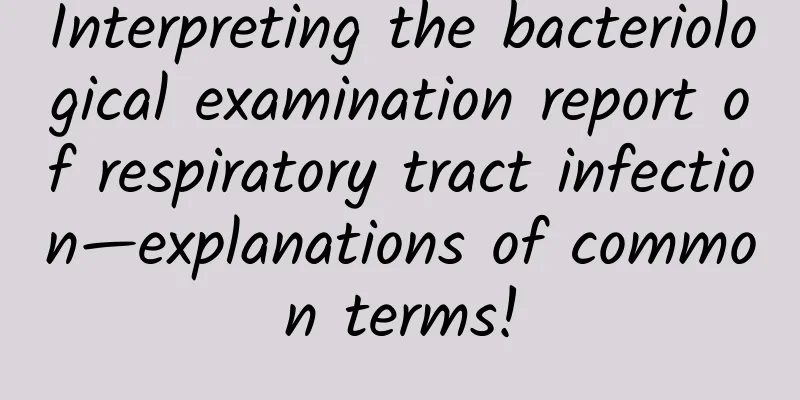Interpreting the bacteriological examination report of respiratory tract infection—explanations of common terms!

|
Author: Lu Binghuai, Chief Physician of China-Japan Friendship Hospital Reviewer: Xiao Dan, Professor of China-Japan Friendship Hospital In the bacteriological examination report of respiratory tract infection, some patients are confused by the unfamiliar terms. Today we will talk about what they mean. Gram-negative cocci or bacilli (+): First, we need to understand a term - Gram staining. Gram staining is a very old staining method, which has a history of more than 100 years since its application. At present, Gram staining is still one of the most commonly used staining methods in microbiology laboratories. It can mainly make different bacteria present different colors. Generally speaking, positive bacteria will appear blue, and negative bacteria will appear red. Based on the staining and the shape of the bacteria, whether spherical or rod-shaped, they are divided into Gram-positive bacilli, Gram-positive cocci, Gram-negative bacilli, and Gram-negative cocci. Through Gram staining and its morphological characteristics, we can roughly infer which type of bacteria it is. Figure 1 Original copyright image, no permission to reprint Gram-negative cocci or bacilli (+) often appear as red bacteria under Gram staining. Depending on the number of pathogens, they can be represented by +, ++, and +++ from few to many, respectively. At most, there may be four "+". The bacteria that cause respiratory tract infections are mainly Gram-positive cocci and Gram-negative bacilli. Among Gram-positive cocci, we are most worried about Streptococcus pneumoniae, which is the most common and easily causes community infections. The next most worried are Staphylococcus aureus, which can cause severe pneumonia, and Streptococcus pyogenes, which causes pharyngeal infections in children. There are many types of Gram-negative rods, including Haemophilus influenzae, Escherichia coli, Klebsiella pneumoniae, Pseudomonas aeruginosa, etc. In addition, Bordetella pertussis is a short Gram-negative rod that can cause whooping cough. Legionella pneumophila can cause Legionnaires' disease. Gram-negative cocci may also cause respiratory tract infections, primarily Moraxella catarrhalis. Gram-positive bacteria rarely cause respiratory tract infections, although some special pathogens can cause them, such as Corynebacterium diphtheriae. In hospitalized patients, those with low immunity, or those with endotracheal intubation, Gram-positive bacteria with weak pathogenicity, such as Corynebacterium striatum, can also cause respiratory tract infections. Epithelial cells or white blood cells> 25/LP: The epithelial cells and white blood cells detected in sputum samples coughed up from the respiratory tract are mainly used to distinguish whether the sample comes from the upper respiratory tract or the lower respiratory tract. For lung infections, pathogens detected in the lower respiratory tract may be the real pathogens. In sputum samples, epithelial cells are the main source of upper respiratory tract infection. If the number of epithelial cells is greater than 25/LP, we usually think that it is from the upper respiratory tract and cannot reflect the situation of lower respiratory tract infection. Those originating from the lower respiratory tract are mainly composed of white blood cells, unless the patient has very low immune function or is granulocytopenic. If the number of white blood cells is greater than 25/LP, we usually think that it comes from the lower respiratory tract and is a qualified sample that can reflect the patient's infection. We need further processing and may detect pathogens. Figure 2 Original copyright image, no permission to reprint Pseudohyphae: occasionally; yeast-like spores: occasionally: This is part of the fungal examination. The shape of the hyphae can be used to distinguish between fungal hyphae and pseudohyphae. Fungal hyphae are common in some filamentous fungi, including Aspergillus, Mucor, Rhizomucor, etc. Pseudohyphae are mainly found in Candida, such as the common Candida albicans, Candida krusei, Candida parapsilosis, etc. When the report shows visible fungal spores and pseudohyphae, it means that Candida is seen in the sample. The presence of Candida in bacteriological examinations of respiratory tract infections usually means that the patient develops dysbacteriosis after using antibiotics. It does not mean that Candida is the real pathogen, because the probability of Candida causing respiratory tract infection is very low. |
<<: What are the symptoms of organophosphorus pesticide poisoning? How to provide first aid?
Recommend
The longer the shelf life of food, the more preservatives it contains?
The longer the shelf life of food, the more prese...
What causes cervical vascular bleeding?
There are many female friends around us who suffe...
Exercising for 5 minutes a day can reduce the risk of dementia by 41%; brewing tea can remove heavy metals in water | Technology Weekly
Compiled by Zhou Shuyi and Pingsheng Some antidep...
How to tell the gender of a baby with four-dimensional ultrasound data
Is four-dimensional color ultrasound accurate in ...
Treatment of pelvic fractures: choosing the right method is crucial
At present, trapezoidal compression stent reducti...
How long after an abortion can I have sex?
Abortion is actually a kind of harm to women'...
What kind of throat lozenges can pregnant women take?
Pregnant women should focus on protecting their h...
What is the reason for white hair on the vulva?
Pubic hair is one of the signs of female private ...
The dangers of artificial twins
Nowadays, many couples want to have twins, but th...
What is the cause of delayed menstruation and brown discharge?
Menstruation is very important for female friends...
What is the chance of pregnancy with an IUD?
Wearing an IUD is not a foolproof safety measure,...
Does curettage hurt? How long does it take?
Dilation and curettage is a surgical procedure us...
New virus? Highly lethal? Don’t be fooled! Three things you must know about “human metapneumovirus”
[This issue's rumors]: “It’s not COVID-19 or ...
Harvard study: Changing this seasoning can actually reduce the risk of dementia?
Compiled by: Gong Zixin According to a report rel...
General practice community chronic disease health promotion series - early screening for dyslipidemia
General practice community chronic disease health...









